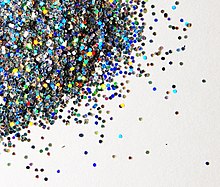Glitter: Difference between revisions
No edit summary |
m Reverted 1 edit by 69.43.88.2 (talk) to last revision by Flyer22. (TW) |
||
| Line 4: | Line 4: | ||
{{commons category|Glitter}} |
{{commons category|Glitter}} |
||
'''Glitter''' describes an assortment of very small, flat, and reflective particles. When these particles are applied to surfaces, they each reflect light in different angles causing the surface to sparkle or glitter. |
'''Glitter''' describes an assortment of very small, flat, and reflective particles. When these particles are applied to surfaces, they each reflect light in different angles causing the surface to sparkle or glitter. Glitter is similar to, but smaller than [[confetti]] or [[sequins]]. Glitter has been produced and used decoratively since prehistoric times from many different materials including [[mica]]{{Citation needed|date=November 2012}}, insects,<ref>{{ cite web | title=Beauty, Hairstyles and Cosmetics in Ancient Egypt | url=http://factsanddetails.com/world.php?itemid=1938&catid=56&subcatid=365 | publisher=Facts and Details | accessdate=November 12, 2012 }}</ref> glass, and now plastic. |
||
==Modern Glitter== |
==Modern Glitter== |
||
Revision as of 04:15, 9 April 2013

Glitter describes an assortment of very small, flat, and reflective particles. When these particles are applied to surfaces, they each reflect light in different angles causing the surface to sparkle or glitter. Glitter is similar to, but smaller than confetti or sequins. Glitter has been produced and used decoratively since prehistoric times from many different materials including mica[citation needed], insects,[1] glass, and now plastic.
Modern Glitter
Today over 20,000 varieties of glitter are manufactured in a vast number of different colors, sizes, and materials.[2] Over 10,000,000 pounds of glitter was purchased between the years of 1989 and 2009 alone. Commercial glitter ranges in size from 0.002"2 (50 microns) to 0.25"2 (6250 microns).[3] First, flat multi-layered sheets are produced combining plastic, coloring, and reflective material such as aluminum, titanium dioxide, iron oxide, and bismuth oxychloride. These sheets are then cut into tiny particles of many shapes including squares, rectangles, and hexagons.[4]
The first production of modern glitter has sometimes been credited to American cattle farmer and machinist, Henry Ruschmann, shortly after the start of WWII. With German glass glitter unavailable due to the war, Ruschmann found a market for scrap material ground into glitter made of plastics.[5] He founded Meadowbrook Inventions, Inc. in Bernardsville, New Jersey, and the company is still a major producer of industrial glitter today.[6]
Ancient Glitter
As early as 30,000 years ago, flake mica was used to give caves paintings a glittering appearance[citation needed]. Primitive humans are believed to have used cosmetics,[7] which may have included powdered hematite, a sparkling mineral.[8] Over 6,000 years ago, the ancient Egyptians produced glittering cosmetics from the iridescent shells of beetles[9] as well as finely ground green malachite crystal.[10] Prior to modern plastics, particles of glass were used to create glittering surfaces[citation needed], and glass glitter is still produced commercially.
Uses
Glittering surfaces have been found to be used since prehistoric times in the arts and in cosmetics. Sparkling fabrics have come into fashion through the ages. Prior to fabrics made with modern glitter, sequins were sewn or woven onto fabric to give it a glittering appearance. Today, edible glitter made from gum arabic and other ingredients is even used by culinary artists[citation needed].
Glitter is used in cosmetics to make the face appear more shiny or sparkly. Additionally, it is used in children's arts and crafts to color and texture items. Because particles are so small but are usually colorful and bright, they often remain stuck to clothing, skin, and furniture and can be a hassle to remove.
Due to its unique characteristics, glitter has also proven to be useful forensic evidence. Because of the tens of thousands of different commercial glitters, identical glitter particles can be compelling evidence that a suspect has been at a crime scene. Glitter particles are easily transferred through the air or by touch, yet cling to bodies and clothing, often unnoticed by suspects.[11]
References
- ^ "Beauty, Hairstyles and Cosmetics in Ancient Egypt". Facts and Details. Retrieved November 12, 2012.
- ^ "90 Seconds with Meadowbrook". Meadowbrook Inventions, Inc. Retrieved November 12, 2012.
- ^ "(No Title)". Meadowbrook Inventions, Inc. Retrieved November 12, 2012.
- ^ "(No Title)". Glitterex Corporation. Retrieved November 12, 2012.
- ^ "10,000,000 pounds of glitter was purchased between 1989 and 2009. All That Glitters: The History of Shiny Things". Etsy.com. Retrieved November 12, 2012.
- ^ "(No Title)". Meadowbrook Inventions, Inc. Retrieved November 12, 2012.
- ^ "Did Neanderthals wear make-up?". Archaeology News Archive. Retrieved November 12, 2012.
- ^ "The History of Glitter". Auntie Illumi. Retrieved November 12, 2012.
- ^ "Beauty, Hairstyles and Cosmetics in Ancient Egypt". Facts and Details. Retrieved November 12, 2012.
- ^ "Ancient Egyptian Eye Makeup". Country Facts. Retrieved November 12, 2012.
- ^ "GLITTER as Forensic Evidence" (PDF). NFSTC. Retrieved November 12, 2012.
